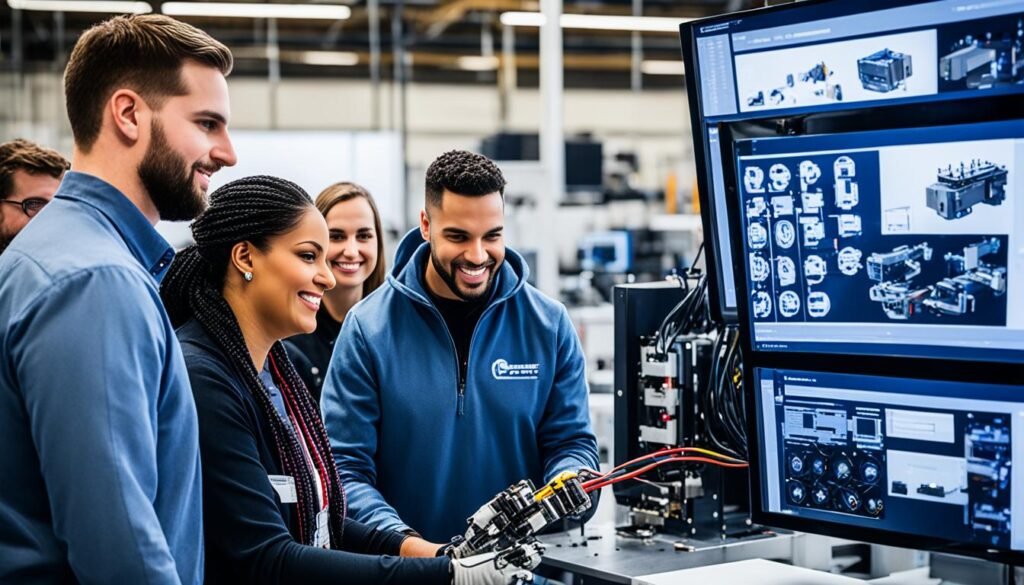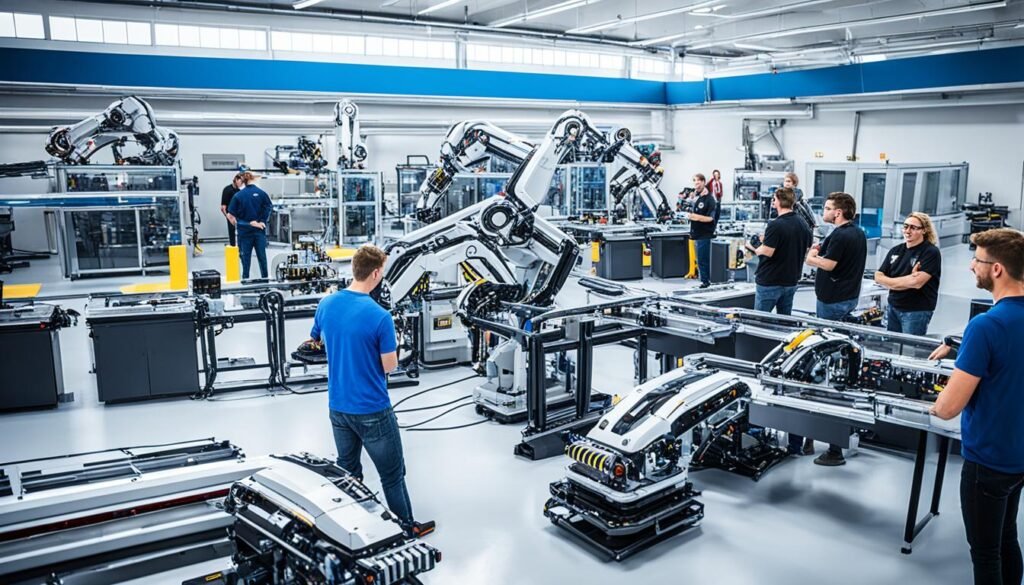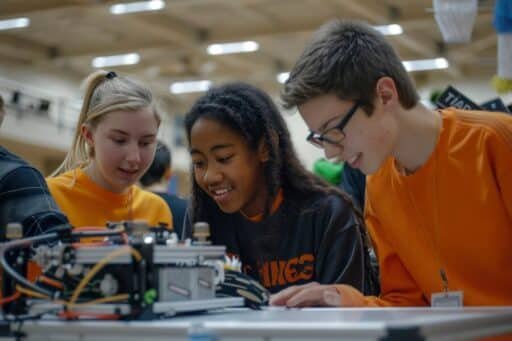In the 21st century, Career and Technical Education (CTE) programs are changing fast. The Fourth Industrial Revolution has brought big shifts. This is leading CTE to use new and innovative methods to get students ready for future jobs.
The changes are clear on college campuses, especially community colleges. They are introducing programs in high-tech fields like mechatronics and robotics. They are also mixing old and new by combining apprenticeship programs with IoT/IIoT training. This shows how important it is for schools and job creators to work together on education.
Also Read: The Role Of Technology In Shaping Education Degree
One big challenge is to show students and parents the cool jobs available in manufacturing. Schools need help to make learning spaces that look like real work settings for digital jobs. Employers have a big part to play in this too. By supporting apprenticeships and certification programs, they can bridge the skills gap and get students ready for top jobs.
Key Takeaways:
- CTE programs are changing quickly to match the Fourth Industrial Revolution’s challenges.
- Community colleges are at the forefront, offering new programs in mechatronics and robotics.
- Strong partnerships are needed among schools, employers, and leaders to provide effective learning programs.
- It’s a big task to get students and families excited about high-tech manufacturing jobs. Schools need more help to do this well.
- By backing apprenticeships and certifications, employers can help students get the skills they need for top careers.
Also Read: How To Choose The Best Education Degree Program For Your Goals?
Introduction to Career and Technical Education
The concept of career and technical education (CTE) started in the late 1800s and early 1900s. This was when industrialization began. It made societies change a lot. Schools started offering vocational courses. These courses aimed to get students ready for jobs in agriculture, manufacturing, and trade industries.
Also Read: The Ultimate Degree: Navigating The Path To The Highest Level Of Education
Historical Roots of CTE
In 1917, the United States saw a big step with the Smith-Hughes Act. It provided money for vocational education programs. This was the first time the U.S. supported these programs. It marked the start of vocational education in American schools.
Also Read: Education Programs At The American College Of Education
The Shift to Career and Technical Education
By the mid-1900s, people were realizing that CTE had to change along with the economy. This led to the name “Career and Technical Education” replacing “vocational education“. This shift made the education approachly broader and more inclusive. It focused on teaching both job-specific skills and academic and technical knowledge.
Also Read: Specialized Teaching Strategies: The Benefits Of A Masters In Special Education
Evolution of CTE in the 21st Century
The 21st century is bringing big changes to career and technical education (CTE). This change is thanks to several important factors. They’ve reshaped how we get ready for work and choose our career paths.
Technology Integration
Technology is changing work in many fields quickly. So, CTE programs are now teaching technology education, coding, and digital literacy. This makes sure students learn the digital skills they need for today’s 21st century jobs.
Industry Partnerships
CTE programs are teaming up with local businesses and industries more and more. This helps students connect what they learn with real jobs. Through internships, apprenticeships, and job shadowing, students get crucial real-world experience. This way, they’re better prepared for jobs that are in high demand.
Career Pathways
CTE now offers many career pathways, like healthcare, IT, culinary arts, and more. Students have many options to explore based on their interests and strengths. This makes their education more personal and engaging.
Dual Enrollment Programs
Many CTE programs allow students to join dual enrollment opportunities. This lets high schoolers earn college credits alongside their CTE classes. It makes getting ready for a career faster and saves money on higher education.
Emphasis on Soft Skills
Soft skills are now a big deal in CTE. Programs focus on communication, teamwork, problem-solving, and adaptability. These skills are key for any job. They help students adapt to the changing workforce and meet industry demands.
Addressing the Skills Gap

Today, Career and Technical Education (CTE) aims to fill the skills gap we see in many fields. As tech grows, industries need a more skilled workforce. CTE gives industry-relevant training and chances to get hands-on experience. Thus, graduates are fully job-ready and can meet changing job needs well.
This setup helps students excel in high-demand positions. It also supports businesses by offering them the skilled workers they need. So, CTE programs are key. They make sure workers have the skills that today’s jobs want. This way, industries can grow with a steady group of job-ready individuals.
The Future of Work and CTE

What is the Future of Work?
The world is moving into the Fourth Industrial Revolution. It combines new tech in areas like the physical, digital, and biological worlds. This tech is changing how we work and live. Breakthroughs in artificial intelligence, robotics, big data analytics, and the Internet of Things are happening fast. These changes are affecting almost every job field.
How Will the Future of Work Change Employment?
New tech in the workplace raises questions about job security. Jobs that involve repetitive tasks are most likely to be automated soon. Nearly half of all job tasks could be done by machines in the future. But many believe that new tech will change the nature of our work, not just replace it. This means we might see jobs evolve, with people working more together with tech, rather than losing them.
Skills Needed for the Future of Work
To succeed in the future, we need certain skills. These include skills like critical thinking, creativity, and communication. Also important are digital skills like managing data and programming. And we can’t forget about business skills like project management and design.
CTE and the Future of Work
CTE is key in preparing students for the future job market. It teaches skills that are useful in many different jobs. Skills like critical thinking and communication are super important. CTE also offers paths to further education and works closely with industries. This ensures students are ready for new job trends.
Impact of Fourth Industrial Revolution Technologies

The world stands at the start of the Fourth Industrial Revolution. It’s a time when the physical, digital, and biological worlds come together. This happens with the help of artificial intelligence, robotics, big data analytics, and the Internet of Things. These technologies will change how we work and live, affecting many industries.
People worry about jobs with the rise of these technologies. Up to 50% of activities now done by people could be done by machines soon. Yet, the bigger change is how we will work with these technologies. We will do new kinds of tasks together.
Many of us will need to learn new things to keep up. Instead of losing jobs, we might just change what we do. To succeed, we need to work on skills like thinking critically, being creative, and talking well. We also need to know how to use new technologies for work in the future.
Helping everyone get ready for these changes is not simple. People from different groups don’t all start with the same skills. For example, people of color may face bigger challenges with learning new technologies. This shows why Career and Technical Education (CTE) is so important. It helps make sure everyone can have the skills they will need for jobs in the future.
Career And Technical Education Programs Adapting

The world is changing fast, and CTE programs are keeping up. Especially on college campuses and in community colleges. There, you’ll find exciting stuff like mechatronics, advanced manufacturing, robotics, and even cyber-physical simulated smart factories. These changes are because industries want workers who are ready for the challenges of today and the future. They need to have technical skills, employability skills, and even entrepreneurial skills.
Aligning Curriculum with Industry Needs
CTE programs are working hard to match what they teach with what the workplace needs. This means giving students chances for hands-on learning. And it’s not just in the classroom. They’re connecting with local businesses and industry leaders. This helps make sure that the things CTE students learn are exactly what they’ll need for their careers. It also includes doing things like internships, apprenticeships, and job shadowing to get real-life work experience.
Hands-On Learning Opportunities
CTE programs love hands-on learning because it lets students use what they know in real life. These chances let students see the real issues and skills needed in their future jobs. It makes them better prepared for work when they graduate.
Industry-Recognized Certifications
To get students ready for jobs, CTE programs also offer industry-recognized certifications. These show that students are really skilled in certain areas. Having these certificates makes CTE students more likely to get hired. Employers see these as proof that students have what it takes to do well in their job.
Partnerships with Businesses and Industry
Building strong industry partnerships is key for making sure workforce education matches what employers need. Supporting apprenticeship programs and certification programs helps close the technical skills gap. This makes sure students leave school ready for in-demand careers.
For employers, working with students year-round brings fresh ideas and energy. This pushes them to keep going, even when things get tough. Together, they create better learning solutions that help everyone succeed and look to the future.
Thanks to employer partnerships, students can learn through doing work-based learning, like internships, apprenticeships, or job shadowing. These jobs give them real-world experience and a chance to show what they can do. Plus, they might earn certificates that employers recognize, making them more likely to get hired in their community.
| Industry Partnerships | Benefits |
|---|---|
| Apprenticeship Programs | Provide structured, on-the-job training and mentorship, leading to industry-recognized credentials and skilled, job-ready graduates. |
| Certification Programs | Offer specialized, employer-endorsed training and assessments, validating the technical skills and knowledge required for in-demand careers. |
| Work-based Learning | Internships, apprenticeships, and job shadowing opportunities give students hands-on experience and exposure to real-world work environments. |
| Employer Engagement | Regular feedback, curriculum development, and resource sharing help ensure CTE programs remain relevant and aligned with industry needs. |
“The enthusiasm and curiosity of the students and schools we work with year-round inspire us to push through times of disruption and uncertainty in the industry, and continue building new and improved learning solutions that maximize potential and build a better future.”
Equity and Accessibility in CTE
Not all groups have the same digital literacy skills for work. Today, 31 percent of American workers lack these skills. This is a bigger issue for people of color. For example, half of Black workers and over half of Latino workers are in this group.
CTE is key in reducing the achievement gap and opportunity gap. It does this by focusing on fairness and giving all students a shot at career success. It uses methods like personalized learning and student support services.
These programs work on bringing more diversity and inclusion into the workforce. They help make sure everyone has the skills and support they need for work success in the future.
Challenges and Opportunities

The world of work is changing quickly, thanks to the Fourth Industrial Revolution. Career and Technical Education (CTE) programs help students prepare for these changes. They face challenges in telling students and parents about career options. These include manufacturing, where learning with the latest technology is key.
Funding and Resources
Many CTE programs struggle to get enough funding and resources. This hinders their ability to teach students digital literacy and technical skills. Working with industry can help. It brings the latest technology and tools to these programs.
Teacher Training and Professional Development
CTE educators need ongoing teacher training and professional development. This keeps them up on industry changes and methods. More training means better teaching. It helps students learn the skills they need in the digital economy. Making sure every student has what they need to succeed is vital too.
| CTE Challenges | CTE Opportunities |
|---|---|
| Educating students and parents about high-tech careers | Strengthening industry partnerships to access latest technologies |
| Securing adequate funding and resources | Investing in teacher training and professional development |
| Providing innovative learning environments and technology integration | Addressing equity and accessibility concerns for all students |
| Bridging the skills gap and workforce diversity challenges | Preparing students for the future of work with relevant skills and knowledge |
Also Read: What Does An Education Specialist Do?
Role of State and Federal Policies
State and federal policies are key in shaping Career and Technical Education (CTE) programs’ future. These policies help face challenges like the Fourth Industrial Revolution. They aim to make sure CTE programs match the changing job market well.
State policies focus on funding and resources for CTE. They ensure programs have what’s needed to teach students about popular careers. They might also encourage partnerships with businesses. These partnerships can help create certifications and opportunities like apprenticeships.
Federal policies, on the other hand, support workforce and economic growth through CTE. The Perkins V Act gives money to CTE programs and urges curricula to meet local industry needs. It also strives for fairness and access, so everyone can benefit from CTE.
When state and federal policies support CTE wisely, programs can help close the skills gap. They brighten economic prospects and give everyone a fair shot in the job world’s future.
FAQs
Q: What is Career and Technical Education (CTE)?
A: Career and Technical Education (CTE) provides students with the knowledge and skills they need to prepare for success in both college and careers.
Q: How is CTE adapting to industry changes?
A: CTE programs are constantly evolving to meet the demands of the changing workforce. They collaborate with industry partners to ensure students are learning relevant skills.
Q: What are career clusters in CTE?
A: Career clusters in CTE group related careers together to help students explore a wide range of career options within a particular field.
Q: What are industry-recognized credentials in CTE?
A: Industry-recognized credentials are certifications that demonstrate a student’s proficiency in a specific skill or knowledge area valued by employers in the industry.
Q: How does CTE support career success?
A: CTE programs provide students with hands-on training and real-world experiences that help them develop the skills needed to succeed in their chosen career paths.
Q: What role do CTE educators play in preparing students for careers?
A: CTE educators play a crucial role in providing guidance, instruction, and mentorship to students as they explore different career pathways and develop their skills.
Q: How do CTE courses prepare students for postsecondary education?
A: CTE courses equip students with the academic knowledge and technical skills needed to pursue further education in their chosen career fields.





